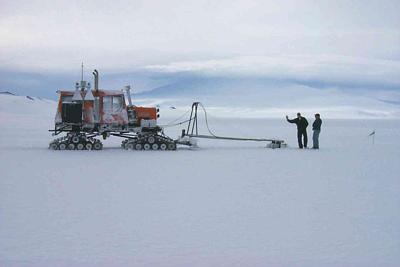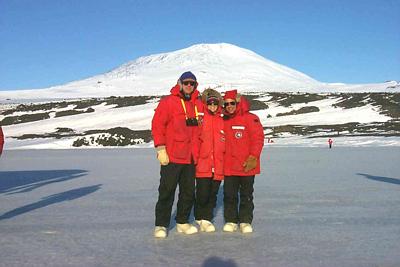30 November, 1999
McMurdo Station, Ross Island, Antarctica
Tuesday
Another day spent much the same as the other. The gas chromatograph (GC)
has some serious problems. We are backlogging samples (we are now 2 days
behind schedule) and are spending most of our time troubleshooting. As soon
as we think we have a handle on the problem, another problem takes its
place! Julie, Maite, and Mark continue to perform other analyses that will
help in analyzing what processes are occurring in Lake Bonney. Bess and I
work on the GC.
I spent an hour or so late tonight with Larry Krisseck, a sedimentologist
with the Cape Roberts drilling project. He helped me identify some of the
rock samples that I have secured from Taylor Valley. He described the major
rock types that you find in the Ross Island area. They include the
Koettlitz Group (typically the oldest), the Granite Harbor intrusives
(igneous), the Beacon sediments, Ferrar dolorites, and the McMurdo
volcanics. I have representatives from most groups, but without further
chemical tests, some of the rocks will remain a mystery!
ANSWER TO YESTERDAY'S QUESTION: A crevasse is a crack in the ice that forms
when there are forces trying to pull the ice apart. They are never deeper
than about 200 ft. Crevasses will often be covered with snow bridges.
Winds blow snow into the crevasses and the snow, sticking to the sides of
the crevasse, slowly builds up, creating a bridge. Crevasses begin small
and can become 30 ft. wide. As they move along with the glacier, they will
eventually close up. Be sure to read the Polar Profile about two crevasse
hunters!
TODAY'S QUESTION: What is the SWEAT Hypothesis?
POLAR PROFILE: The International Trans-Antarctic Scientific Expedition
(ITASE) will study the ice that covers Antarctica. The team is made of
scientists from 15 countries and they will spend 4 years studying Antarctic
ice. The United States ITASE team has been charged specifically with the
study of the West Antarctic Ice Sheet. Traveling in Tucker Sno-Cats, the
ITASE members will stop along a predetermined route every 100 km to gather
data. At each of these stops, they will drill into the ice to a depth of 50
- 70 m. This depth represents about 200 years of ice development. The ice
cores will be taken back to the United States for analyses. How fast does
the snow accumulate, where are the melting layers of the ice , and what is
the internal temperature of the ice sheet, are all questions that the
scientists hope to answer. I was fortunate to have made the acquaintance of
several members of this extraordinary team. Two of them, Steve Arcone and
Bert Yankielun, from the Cold Regions Research and Engineering Lab (CRREL)
in New Hampshire, will use radar to study the snow layers.
Steve and Bert have attached radar systems (one of them actually designed by
Bert), to their Tucker. Radio waves travel through ice very well and so
the pictures the radar sends back to Steve and Bert, will sort of paint a
picture of what the underlying layers of snow look like. What interested me
the most was that a slight change in the radar picture, a small dip in the
layers, could indicate that the Tucker is about to cross a fragile crevasse
snow bridge! This area of Antarctica has never before been studied and they
suspect that there are many crevasses. Having an early warning system will
insure the team's safety. Many things have to 'come together' for this to
work correctly and Steve and Bert must be able to visually recognize these
subtle changes in the layering! Their mission is an exciting and dangerous
one! I think of them as our 'Crevasse Hunters'! We are all looking forward
to their safe return in a few weeks. You can access a web site about the
ITASE team by logging onto www.SECRETSOFTHEICE.org. They will provide
updates about their adventure, on the site!
Sharon
JUST FOR KIDS!!!!!
We are still trying to get the gas chromatograph (GC) working again! We
have been heating parts of the GC, changing some of the way it's all hooked
up, and timing our injections of gas. Nothing seems to be working!
Scientists can be very patient and we will keep working until we have solved
this problem!
I spent some time with a geologist tonight. What does a geologist do? This
geologist, Larry Krissek, studies how rocks are made into sediments, like
sand and gravel, and how these sediments are layered to make rocks! I
brought some rock samples from Taylor Valley with me and Larry told me what
kinds of rocks I had collected. Some of the rocks were a mystery! To
identify some kinds of rock, you must perform a chemistry test on them.
ANSWER TO YESTERDAY'S QUESTION: A crevasse is a crack in the ice that forms
when something is pulling the ice apart (think of how an earthquake moves
rock). Crevasses are never deeper than about 200 ft. Crevasses will often
be covered with snow bridges. Winds blow snow into the crevasses and the
snow, sticking to the sides of the crevasse, slowly builds up, creating a
bridge. Crevasses begin small and can become 30 ft. wide. As they move
along with the glacier, they will eventually close up. Be sure to read the
Polar Profile about two crevasse hunters!
TODAY'S QUESTION: What is the SWEAT Hypothesis?
POLAR PROFILE: The International Trans-Antarctic Scientific Expedition
(ITASE) will study the ice that covers Antarctica. The team is made of
scientists from 15 countries and they will spend 4 years studying Antarctic
ice. The United States ITASE team will travel in Tucker Sno-Cats in West
Antarctica. They will stop and gather ice samples every 100 km. The ice
samples will tell the scientists about the climate in Antarctica over the
last 200 years. How fast does the snow accumulate, where are the melting
layers of the ice , and what is the temperature of the ice sheet, are all
questions that the scientists hope to answer. I was fortunate to have made
the acquaintance of several members of this extraordinary team. Two of
them, Steve Arcone and Bert Yankielun, from the Cold Regions Research and
Engineering Lab (CRREL) in New Hampshire, will use radar to study the snow
layers.
Steve and Bert have attached radar systems (one of them actually designed by
Bert), to their Tucker. Radio waves travel through ice very well and so
the pictures the radar sends back to Steve and Bert, will sort of paint a
picture of what the layers of snow look like. What interested me the most
was that a slight change in the radar picture, a small dip in the layers,
could indicate that the Tucker is about to cross a fragile crevasse snow
bridge! This area of Antarctica has never before been studied and they
suspect that there are many crevasses. Having an early warning system will
help to keep the team safe. Steve and Bert must be able to recognize these
little changes in the layering so that they can send out the alarm that a
crevasse is ahead! Their mission is an exciting and dangerous one! I think
of them as our 'Crevasse Hunters'! We are all looking forward to their safe
return in a few weeks. You can access a web site about the ITASE team by
logging onto www.SECRETSOFTHEICE.org. They will provide updates about their
adventure, on the site!
Sharon

This is the Tucker Sno-Cat in which Steve and Bert will operate their radar and interpret the graphic displays. There are two radar systems. The system to the front of the Tucker will help them to 'see' a crevasse before the Tucker is actually over the crevasse. The radar system attached to the side of the Tucker (the two upside-down cones) was developed by Bert. If they wait for Bert's radar to detect the presence of a crevasse, it will be too late! The Tucker will be sitting over the crevasse! Both systems will help them to analyze the layer effects of snow.

Bert, Sharon, and Steve on a recent trip to Cape Evans. Mount Erebus, Antarctica's only active volcano, is in the background.
Contact the TEA in the field at
.
If you cannot connect through your browser, copy the
TEA's e-mail address in the "To:" line of
your favorite e-mail package.
|
